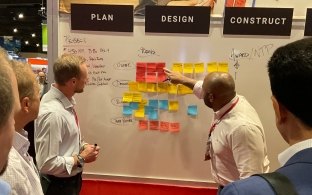Leaning in: Construction Team Embraces Takt Planning on WUSM Neuroscience Research Building
Efficiencies gained through Takt planning have helped accelerate the installation of mechanical and electrical system components.


Each morning at 8:30 a.m., foremen and crew leaders working on the Neuroscience Research Building under construction at Washington University School of Medicine gather on each floor of the 11-story structure.
During this 15-minute huddle, team members review the daily crew schedule, address potential conflicts, and ensure the $616 million project remains on track. Careful planning reduces rework, positions crews to succeed and avoids delays.
Guiding these discussions is a Takt plan, a lean construction scheduling tool that visually documents all work activities scheduled to take place each week throughout the project’s duration.
What is Takt Planning?
Takt planning originated in the manufacturing industry to optimize production to meet consumer demand. In construction, a Takt plan is used to align schedules, material deliveries and other factors to reduce downtime and rework.
“The beauty of a Takt plan is that it makes everything visual,” says McCarthy Project Superintendent Josh Kreitler. “It consolidates a 170-page conventional P6 construction schedule onto a single color-coded page so that all of our trade partners can quickly understand where they’re supposed to be.”
A primary goal of Takt planning, in lean construction terms, is to create “flow.” In other words, the objective is for each project phase to progress in a logical sequence with no interruptions, delays, or bottlenecks. “Essentially, we want to eliminate waiting on workers or workers waiting on work,” explains Kreitler.

Maintaining flow can be a tall order, particularly on a large, complicated building with an ambitious schedule and dozens of trade partners. The key is establishing a consistent rhythm in the schedule (“Takt” is a German word that translates to rhythm, beat, or cadence.)
Takt Planning in Action
On the Neuroscience Research Building, a five-day rhythm directs the activities of all work crews: from mechanical, electrical, and plumbing contractors; to metal stud framing and drywall contractors; to carpenters and painters. “We have defined areas, a distinct sequence of work, and crews move every five days,” says Kreitler. “That creates stability for planning and a defined schedule for each team of specialty contractors.”
The consistent rhythm also helps facilitate the just-in-time delivery of materials and components to the job site. “The Takt plan is very detailed and systematic, which helps ensure our floor crews have the materials and tools they need to do the job. We also make sure they have them when they need them,” says Dan Blanton, project executive of the Murphy Corrigan joint venture overseeing the mechanical system components.
While the Takt planning process is highly structured, it’s also flexible to accommodate the inevitable shifts during construction. “We’re constantly negotiating in the field, but changes don’t happen on the fly. Instead, we make sure we incorporate them into the overall plan,” says Kreitler, noting that superintendent-level team members gather each afternoon to discuss project logistics and big-picture activities. “We all have to agree before adjusting, such as shifting a sequence or adding a buffer week,” he says.
Prefabrication and Collaboration Drive Efficiency
As one of the nation’s largest neuroscience research centers, the 609,000-square-foot building will bring together nearly 100 interdisciplinary research teams to study Alzheimer’s disease, Parkinson’s disease, and other nervous system disorders. The project, which includes an adjacent 1,800-space parking structure, also ranks as the largest in the history of Washington University in St. Louis.

Efficiencies gained through Takt planning have helped accelerate the installation of mechanical and electrical system components, which represent the most extensive scope of work in the research building.
About 90 percent of the M/E/P systems are prefabricated and pre-tested in several local prefab shops before delivering them to the job site for installation. “Prefabrication was only possible because of the detailed 3D modeling and intense coordination we did early on,” says McCarthy’s Chris Fava, who serves as M/E/P superintendent on the project. “This enabled all parties to understand the spatial constraints and generate fabrication drawings they could follow in the shop.”
Constructing essential components offsite has significantly reduced the number of onsite laborers required to install M/E/P components and decreased the amount of waste generated at the job site.
“Because of the way crews progress through the building, the Takt plan allows us to manage our overall manpower on the project much more efficiently,” says Ryan Freeman, president of PayneCrest Electric, the project’s electrical contractor.
According to Blanton, the Takt plan provides a systematic process for crews to install their project scope most efficiently and economically. “For too long, it’s been left up to the guys in the field just to figure it out, which ends up burdening the company with the largest scope of work,” he says. “Takt planning eliminates 95% of that inefficiency. It creates a collaborative team environment from day one.”

And because every team member interacts with the Takt plan — from the foreman to the person installing the material — project leaders believe everyone takes more ownership and pride in their work.
Anticipating Change, Delays and Challenges
The process also helps crews pinpoint potential issues before they lead to costly delays, according to PayneCrest Superintendent Joe Wilmes. “We’re able to identify so many potential conflicts and problems long before we install a product, so the owner has more time to make informed, educated decisions,” he says.
Freeman credits McCarthy’s expertise in overseeing trade relationships for the smooth execution of work. “Our success depends on the construction manager’s ability to develop the plan and coordinate all of the trade partners to execute the work efficiently,” he says.
Though most team members had no prior experience with Takt planning before working on this project, many have become enthusiastic supporters. “I’m a huge fan,” Wilmes says. “I would sell this system to anyone, and that’s coming from a skeptic.”
Blanton believes Takt planning may even become the standard scheduling method for commercial construction projects in the next five years. “A caveat is that you’ve got to have talented people running and organizing the project,” he says. “When done well, the way it is here, it’s the only way to build a project.”
The Neuroscience Research Building team remains on schedule, and construction is expected to wrap up in June 2023.
Learn more about Takt planning and all the ways McCarthy improves efficiencies. Get in touch and start your project today.



